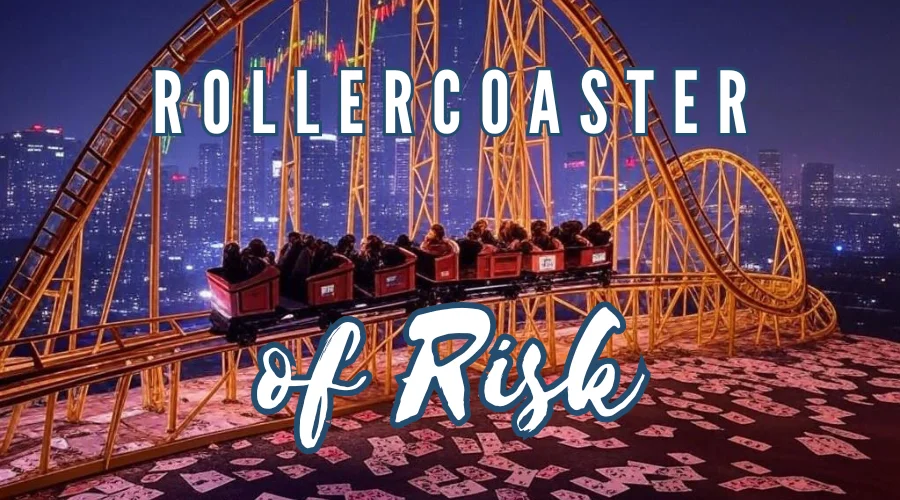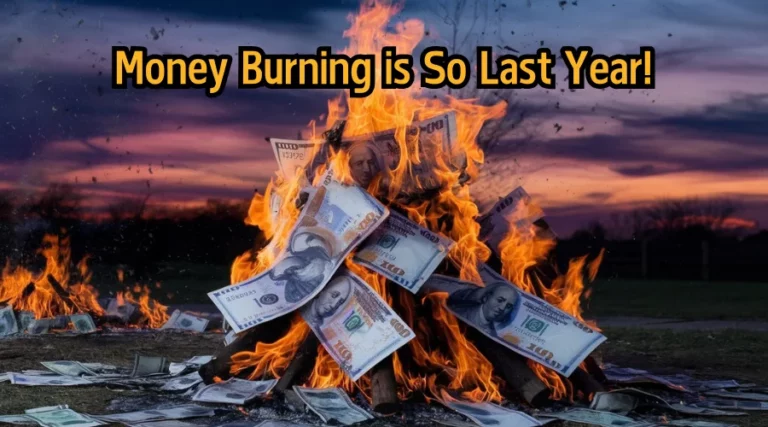Discover Why Chasing High Rewards Can Lead to High Regrets
Boomer Blogger Bites
- Unpacking what makes a stock risky
- Exploring the psychological allure of high-risk investments
- Highlighting historical and modern examples of investment bubbles
- Sharing laugh-out-loud stories of financial mishaps
Boomer Blogger Basics
- Risk Isn’t Always Rewarding: Learn how most high-risk ventures end in loss.
- History Repeats: Understand the recurring patterns in market bubbles.
- Famous Fails: See how even celebrities can make costly investment blunders.
- Modern Madness: Navigate today’s high-risk investment landscape with caution.
Ready to laugh, learn, and maybe avoid the next investment fiasco? Click above to arm yourself with wisdom from one of the greatest investment minds. Let’s turn those giggles into gains!
Risky Stocks: Laugh-Out-Loud Stories Of Poor Investment Decisions
There’s something about risky stocks that can draw us in like moths to a flame. It’s that thrill of a potential jackpot, the stories of people who hit it big. But what exactly makes a stock risky? Typically, these are investments in companies with volatile business models, unpredictable earnings, or they’re part of unstable markets. It means you’re just as likely to see your investment crashed as boom.
People are naturally wired for excitement, and high stakes game of risky stocks can be pretty tantalizing. There’s a psychological aspect here, where the mere chance of high reward tends to overshadow the potential for loss. The rush of chasing a winning stock feels almost like gambling, delivering that adrenaline high as you watch the stock ticker go up and down, hoping you’ve made the right call.
Statistics, however, paint the real picture. A hefty portion of those venturing into high-risk stocks end up on the losing end. According to some studies, most day traders actually lose money. This reality check underscores the importance of understanding that with great risk often comes the great possibility for loss.
Mistakes are part of the game – it really is a game we are playing. We know that solid investment strategies is what we should be doing from the start of our working life. But life gets in the way and we are left needing to dig our way out of this hole. So we take chances. Our losses don’t have to define our investing journey though. Learning from these errors is what we need to be doing instead of doubling down. We can transform these costly lessons into valuable experience by recognizing the traps we fell into and resolving not to repeat them. This mindset shift is what distills fruitful insights from failure, and where the risk can reward us most is through learning.
Infamous Fool’s Gold: Historical Bubbles and Their Legacy
Stock market bubbles have a way of enticing even the brightest minds. These bubbles occur when asset prices grow based on exuberant speculation rather than intrinsic value, leading to inevitable and often dramatic crashes.
The South Sea Bubble stands as a textbook example. In the early 18th century, the British government granted the South Sea Company a monopoly over trade in the Spanish colonies of South America. Expectations ran wild, with investors pouring money into the company, hoping for immense profits. Isaac Newton, one of history’s greatest thinkers, wasn’t immune. He invested heavily but ended up losing a fortune when the bubble burst in 1720. This tale reminds us that intelligence doesn’t always equate to financial prudence and that market psychology can often cloud better judgment.
Dot.com
The NASDAQ Composite index, heavily influenced by technology stocks, reached its peak on March 10, 2000, at 5,048.62. After this, the index began to decline sharply, eventually losing more than 75% of its value by October 2002. Investors across the globe, blinded by the futuristic potential of the world wide web, pumped billions into newly listed tech companies. Two years later you were left with 25% of what you started with.
History tends to repeat itself, particularly in financial markets, because human psychology remains consistent through the ages, with traits like greed, herding behavior (Fear Of Missing Out), and fear play pivotal roles. Greed often inflates asset bubbles, while the herding behavior (FOMO) drives more people to follow the crowd into speculative investments, and then fear leads to panic selling and market crashes. It is cyclical.
Learning from these historical bubbles, savvy investors can safeguard against future missteps. Always question the fundamentals and be wary of herd mentality. These lessons ensure we’re better equipped to handle the exuberance and caution it with experience.
Laugh-Out-Loud Stories of Personal Financial Mishaps
Take the classic story of an everyday investor who, lured by promises of instant gains, sank a good chunk of their life savings into Theranos, a company boasting revolutionary ‘innovative’ technology for blood testing with just a few drops. Theranos promised to change the medical diagnostics world but was later revealed to be a facade. A carefully crafted hype to bring in money. The investor watched in horror as the company, valued at $9 billion, went bankrupt within weeks after its claims were exposed as fraudulent. These narratives, though financially painful, can educate and entertain us while offering a window into the psyche of the market participant.
Celebrities Are Not Immune to High-Risk Investments
Even some celebrities aren’t immune from making questionable investment decisions. Take for example, Nicolas Cage, the actor known for his eclectic film choices, who admitted to losing millions on real estate. He spent lavishly on properties during the peak of the market, including castles and exotic homes, only to face financial ruin when he couldn’t sell them profitably during the 2008 housing crash.
Another example is the rapper 50 Cent declared bankruptcy in 2015. He invested heavily in the now-defunct company “EminiFX,” which promised high returns through cryptocurrency but was later revealed as a Ponzi scheme. This investment blunder cost him significantly, serving as a stark reminder that financial acumen doesn’t always come with fame.
Similarly, Kim Basinger bought the entire town of Braselton, Georgia, for $20 million in 1989, aiming to turn it into a tourist attraction. However, the plan didn’t pan out, leaving her to file for bankruptcy after being unable to manage the financial burden of the town. Schitt’s Creek was born.
These high-profile blunders by celebrities illustrate that even those with considerable wealth and resources can fall prey to poor investment decisions, highlighting the importance of due diligence and skepticism, regardless of one’s status or fame.
Modern Day Market Laughter: Today’s Riskiest Stocks
Today’s market has no shortage of high-risk, high-reward stocks that continue to draw investors in, often with hilarious or heartbreaking results. Certain tech startups promise the moon but haven’t turned a profit in years, yet they attract vast amounts of capital from the hopeful and adventurous.
Driving In Debt
Founded in 2009, Uber quickly became a global leader in ride-sharing and food delivery services. Despite its rapid growth and widespread adoption, Uber has struggled to achieve profitability. The company has consistently reported substantial losses, yet it continues to attract vast amounts of investment from venture capitalists and public markets.
Working in Debt
Another example is WeWork, a company that provides shared workspaces. Founded in 2010, WeWork expanded rapidly and attracted billions in investment. However, it faced significant financial challenges and controversies, leading to a failed IPO attempt in 2019. Despite these setbacks, WeWork continues to receive investment and support from backers who believe in its potential to transform the real estate and coworking sectors..
Memes Are Laughing at You
These days, meme stocks have taken the spotlight. Spearheaded by online forums and social media platforms, these stocks often see sky-high valuations disconnected from company fundamentals. Investors jump on the bandwagon, driven by hype rather than financial metrics.
Crypto Mania
Cryptocurrencies like Bitcoin, Ethereum, and the hilarious Dogecoin have sparked both mania and mayhem in the investment world. While some have gained immense wealth rapidly, others remember the market crashes where fortunes disappeared in moments. The volatility here is not for the faint-hearted. Remember LUNA?
Can I Order a Pizza?
In the early days of Bitcoin, one man famously spent 10,000 Bitcoins to buy two pizzas. At the time, it was a novel way to use cryptocurrency, but with Bitcoin’s value skyrocketing later, those pizzas ended up being worth millions of dollars.
Book Your Ticket
Promoted as a luxury music festival in the Bahamas, Fyre Festival turned into a disaster when attendees arrived to find inadequate accommodations, poor planning, and no musical acts. The event became infamous for its failed promises and the desperate attempts to salvage it.
Consulting expert opinions can provide clarity amid the chaos of speculative markets. Financial advisors often stress the importance of not putting more money into these ventures than one can afford to lose. In hyper-volatile landscapes, staying informed and keeping emotions steady are key components of sound investment decisions.
Turning Giggles into Gains Through Learning from Laughable Mistakes
Mistakes, no matter how amusing or painful in retrospect, hold immense value for those willing to heed their lessons. Adopting a healthier investment mindset involves balancing the thrill of potential rewards with the necessity of managing risks.
One of the first steps in mitigating investment woes is understanding and employing risk management strategies. Diversification across assets is a fundamental tactic, helping to cushion the blow when one market segment takes a nosedive. Spread your investments to avoid placing all eggs in one daring basket.
Spotting red flags requires sharp observation and patience. Sudden, unjustified price spikes in stocks often suggest speculative bubbles rather than genuine growth. Keep an eye out for these signs to avoid getting swept up in unnecessary excitement.
Financial literacy serves as the foremost tool in making informed decisions. Gaining a basic understanding of market dynamics, analysis techniques, and the behavior of different investment vehicles can empower investors. The more you know, the more equipped you are to navigate the unpredictable twists and turns of high-risk stocks.
Lastly, it’s crucial to cultivate a sense of long-term vision. While short-term gains are enticing, true financial stability often stems from a slow and steady approach. Embracing patience and curbing impulsive decisions foster resilience and better align investment practices with personal financial goals.
Food for Thought
Investing, much like life, is a journey filled with ups and downs, laughter and lessons. While the allure of high-risk stocks can be tantalizing, it’s essential to remember that the foundation of successful investing lies in knowledge, patience, and a balanced approach.
“The stock market is filled with individuals who know the price of everything, but the value of nothing.” – Philip Fisher
By learning from past mistakes, embracing financial literacy, and maintaining a long-term vision, you can turn even the most laughable missteps into valuable gains. Remember, the goal isn’t just to chase the next big thing but to build a stable and prosperous financial future.




